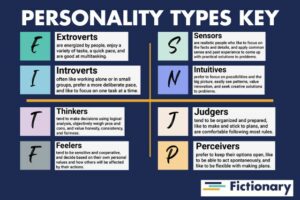
The most important part of building a believable character is showing consistency in that character’s actions and reactions to various situations throughout the story by drawing on personality types.
Aside from internal and external goals, and motivations and challenges built out of backstory, personality traits become important in revealing a consistent and believable character.
What is Personality Theory?
Personality theory is a branch of psychology which aims to explore human nature through personality types.
The model is scientifically defensible, but it also poses the question, do people act in a predictable way based on their personality type? Scientists Carl Jung, Katharine Briggs, and Isabel Briggs Myers are the most notable names in personality theory who would answer yes to this question.

What Are Character Personality Types?
Carl Jung first introduced the idea of introversion and extroversion into the conversation of personality types before expanding into what he called the four functions of personality:
- Thinking,
- Sensation,
- Intuition, and;
- Feeling.
This description is a highly simplified explanation of his early theories for the sake of taking us to his later theories of archetypes, a terminology used not only in the fields of psychology but also in literary discussions and literary theories.
Katharine Briggs and Isabel Briggs Meyers expanded on Jung’s theory to develop a personality test used frequently in various professions and vocations to determine which of the 16 personality types a potential candidate might fall into, and where their successes and challenges may lie.
Much like Jung, Myers-Briggs predicts how one might respond to various situations in life based on their nature to:
- Think,
- Sense,
- Intuit, and;
- Feel.
Why Understanding Fictional Character Personality Types is Beneficial
Writers spend a lot of time with their characters, and the good writers know much more about their characters than the reader ever does.
This deep knowledge a writer has of their characters allows them the ability to write meaningful dialogue and action, showing glimpses into the character as the story progresses.
Writers are told, in various craft books and workshops to:
- Interview their characters,
- List the contents of a character’s pocket, and;
- Journal as their character…
…all in the name of finding that authentic voice.
A writer who understands the different personality types a character can have has an additional lens through which to view this character.
Personality Types for Characters
Here are a few different personality types you can use for your characters.
Myers-Briggs Fictional Characters
Myers-Briggs uses the following pairs of personality types to determine the likely nature of a person.

“We cannot safely assume that other people’s minds work on the same principles as our own. All too often, others with whom we come in contact do not reason as we reason, or do not value the things we value, or are not interested in what interests us.” (Isabel Briggs Myers)
If characters are meant to be believable people outside of the writer’s head, then knowing these personality traits in character allows the writer not only logic in why a character behaves the way they do, but also inspiration for what a character might do in a given situation.
Myers-Briggs Personality Type Example
Consider a character such as Michael Desiato from the recent Showtime series, Your Honor.
Desiato is a judge, and by nature acts as a Thinker.
He is known as an upstanding agent of the law makes decisions using logical analysis of testimony, and objectively weighing the outcomes of his rulings.
He values honesty and fairness, as would be expected of someone in his position. However, when he must pass a judgment that could directly affect the well being of his own son, he acts counter to his nature as a Thinker.
He passes a judgment based on:
- Emotion,
- Fear, and;
- Personal interest.
The moral dilemma presented to him, and the tension of showing a character who must go against his nature to protect his family makes for a compelling character and a storyline.
Consider also, a character like Don Draper from the award-winning series, MadMen.
Don is outgoing, and he sees the big picture in a situation.
He is a definitive decision maker and a natural born leader. These traits serve him well in the flashy world of marketing on Madison Avenue in the 1960’s, but these traits also become his downfall when his ego grows with his success.
Characters can demonstrate their personality types in positive or negative ways, and knowing the spectrum of that behavior gives a writer tools to create dynamic characters. While Jung’s theories also deal with many of the traits on the Myers- Briggs charts, he does not combine them to reveal personality traits in the same way.
Jung explains personality through a list of archetypes.
Jung’s Archetypes Character Personality Type
- The Caregiver seeks service
- The Ruler seeks control
- The Creator seeks innovation
- The Innocent seeks safety
- The Sage seeks understanding
- The Explorer seeks freedom
- The Outlaw seeks liberation
- The Magician seeks power
- The Hero seeks master
- The Lover seeks intimacy
- The Jester seeks enjoyment
- The Everyman seeks belonging
Using Jung’s archetypes can be beneficial for writers who are just forming ideas of a character for a story.
While they are helpful for writers of any genre, writers of fantasy and dystopian genres might find characters fit more overtly in a particular archetype while also having the internal complexity of multiple personality traits.

How to Use Different Personalities for Characters
Personality traits can be helpful for a writer when they are staring at the blank page ready to begin, or they can turn to these graphs and theories when feeling blocked.
Writers just branching out into personality theories might also consider taking some of the online tests as their characters. Myers-Briggs is a commonly used personality test, however there are many other test versions that can be found with basic internet searches.
Below are other ways to begin using personality types when writing.
- Link personality traits with work/vocations in ways that are either natural or conflicting to create tension in the story.
Example: Someone who is outgoing and sees the big picture might be a project leader, a manager, a city official. Conversely, a character who struggles with being an introvert may wrestle constantly with being thrown into the role of public figure.
- Consider how personalities for a character work in the negative as well as the positive.
Example: A character who is altruistic and makes judgments based on what is fair and honorable might be an excellent legal figure, but that same altruism might come off as judgment to a friend seeking compassion with a difficult personal decision that blurs the lines of honesty.
- Use personality types to determine how a character appears.
Example: A character who struggles with introversion might consistently walk with their head down and their clothes might be conservative in style and color.
They might speak softly or resist conversation. Whereas a character who is extremely extroverted might have clothing and behaviors that reveal a desire to be engaging with others most of the time.
- Use the personality traits to anticipate what comes next.
Example: If a writer is feeling stuck in a scene, they might ask themselves, what do I know about the personality of this character? How would they likely behave, speak, react? The answers to these questions can lead to a next paragraph or next scene.
Character Personality Conclusion
Whether a writer is first meeting and developing their characters, or they are writing characters that have been in a story for years, understanding the depth of personality can offer a deeper understanding of the figure on the page.
Vary your characters’ personality types.
For the reader, these characters will be real to them long after the book has closed.


